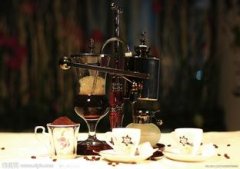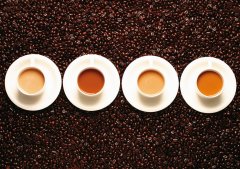How to tell if the coffee has gone bad?

Identification of instant coffee
Coffee is Rubiaceae shrub, coffee tree fruit seeds, semicircle with grooves, fried into coffee powder, brown with special aroma, coffee powder can be drunk after boiling, if the juice is concentrated and then dried into instant coffee.
Fake coffee is mixed with chicory root powder in real coffee, or roasted and crushed grains and beans. Real coffee contains caffeine and has a special aroma. Poor-quality coffee is generally out of date or lax sealing caused by moisture caused by caking, obvious changes in aroma and taste, often the aroma disappears, drinking has a peculiar smell. There is also coffee powder milled as instant coffee, in fact, the two processes are different, instant coffee is concentrated coffee water, spray drying, the process is complex, immediately dissolved after brewing, no floating, no dregs, and although the coffee powder is ground very fine, there is floating matter after brewing, there are dregs, can not be swallowed, can only be blown to drink. It is also common to alter the shelf life of instant coffee packaging. The shelf life of instant coffee is usually two years.
Instant coffee is coffee beans roasted and crushed to get pure coffee, and then extracted and vacuum concentrated into powdered coffee, which can be brewed at any time and dissolve in boiling water. Sensory identification of the quality of instant coffee can be divided into two stages: before brewing and after brewing.
(1) pre-brewing identification?
High-quality instant coffee-brown to dark brown due to different varieties and processes; irregular particles about 2 mm in size, mixed with some fine powder; coffee exclusive aroma due to Maillard reaction during stir-frying. ?
Inferior instant coffee-luster is dark, some are iron black; the tissue state is caked or agglomerated due to dampness or other reasons; the roasting flavor of coffee is weak or can not be smelled at all, replaced by a strong scorched flavor. ?
(2) Identification after brewing?
Good quality instant coffee-completely dissolved, free of dregs and suspended matter; the soup juice is brown and bright; it has a strong coffee aroma; it has a pleasant bitter and sour taste after adding sugar. ?
Inferior instant coffee-after dissolving, there is sediment at the bottom of the cup, and the soup is dark and brown (at the same concentration); the aroma is light, but the scorched taste is strong; after adding sugar, the bitter taste and sour taste are strong, especially the hard aftertaste.
Identification of genuine and fake coffee
The "coffee" here refers to the brown powdered solid drink of raw coffee beans after roasting and grinding. Common adulterants in coffee are chicory root powder, roasted ground grains, etc., or processed with other bean-shaped seeds instead of coffee beans.
Sensory organs
The coffee is brown and powdery, and the coffee has a special aroma due to Maillard reaction during roasting, while fake coffee has no or little such specific aroma.
Density
Put the coffee powder to be tested in the test tube, add saturated sodium oxide solution and shake. The aqueous solution of real coffee should be light amber, and all or almost all of the powder floats, on the contrary, if most of the powder settles at the bottom of the tube, and the aqueous solution is dark yellowish brown, it is a substitute for chicory, roasted grains and other substitutes.
Qualitative examination of chicory root powder
Take about 10 grams of coffee to be tested, boil with 25 ml of water for 5 minutes, add excess alkali or lead acetate solid, shake for about half a minute, stand, wait for clarification and observe. If the upper aqueous solution is clear and colorless, it is pure coffee, and if it produces color, it is proved to be mixed with chicory root powder.
Important Notice :
前街咖啡 FrontStreet Coffee has moved to new addredd:
FrontStreet Coffee Address: 315,Donghua East Road,GuangZhou
Tel:020 38364473
- Prev

How did coffee enter the Chinese market?
Coffee is said to have begun in the early 11 th century and can be found in ancient Arabic documents. Before that, coffee beans in the Arab region were dried and boiled as stomach medicine, and later learned that coffee also had a refreshing effect, coupled with the strict prohibition of alcohol by Muslim precepts. Muslims use roasted juice instead of alcohol as an exciting drink. It is said that the local people know how to use
- Next

On the nobility of Nouak Coffee Nuwak Coffee is hard to come by
Nouak coffee is not easy to come by and is known as the rarest coffee in existence. Specifically, this kind of coffee comes from the Indonesian island of Sumatra, where coffee trees grow for a long time. When the coffee berries are ripe, local farmers deliberately put cats into coffee plantations and let them indulge. Not all cats are blessed to enjoy a coffee feast.
Related
- Beginners will see the "Coffee pull flower" guide!
- What is the difference between ice blog purified milk and ordinary milk coffee?
- Why is the Philippines the largest producer of crops in Liberia?
- For coffee extraction, should the fine powder be retained?
- How does extracted espresso fill pressed powder? How much strength does it take to press the powder?
- How to make jasmine cold extract coffee? Is the jasmine + latte good?
- Will this little toy really make the coffee taste better? How does Lily Drip affect coffee extraction?
- Will the action of slapping the filter cup also affect coffee extraction?
- What's the difference between powder-to-water ratio and powder-to-liquid ratio?
- What is the Ethiopian local species? What does it have to do with Heirloom native species?

